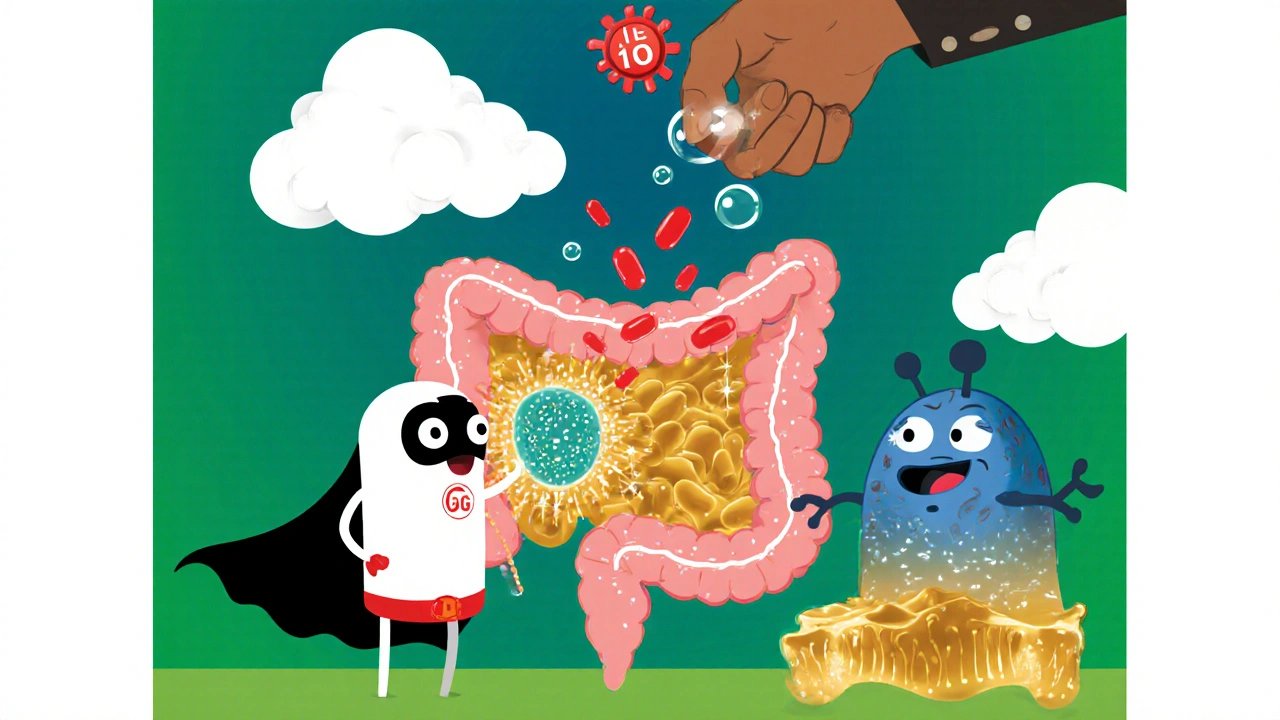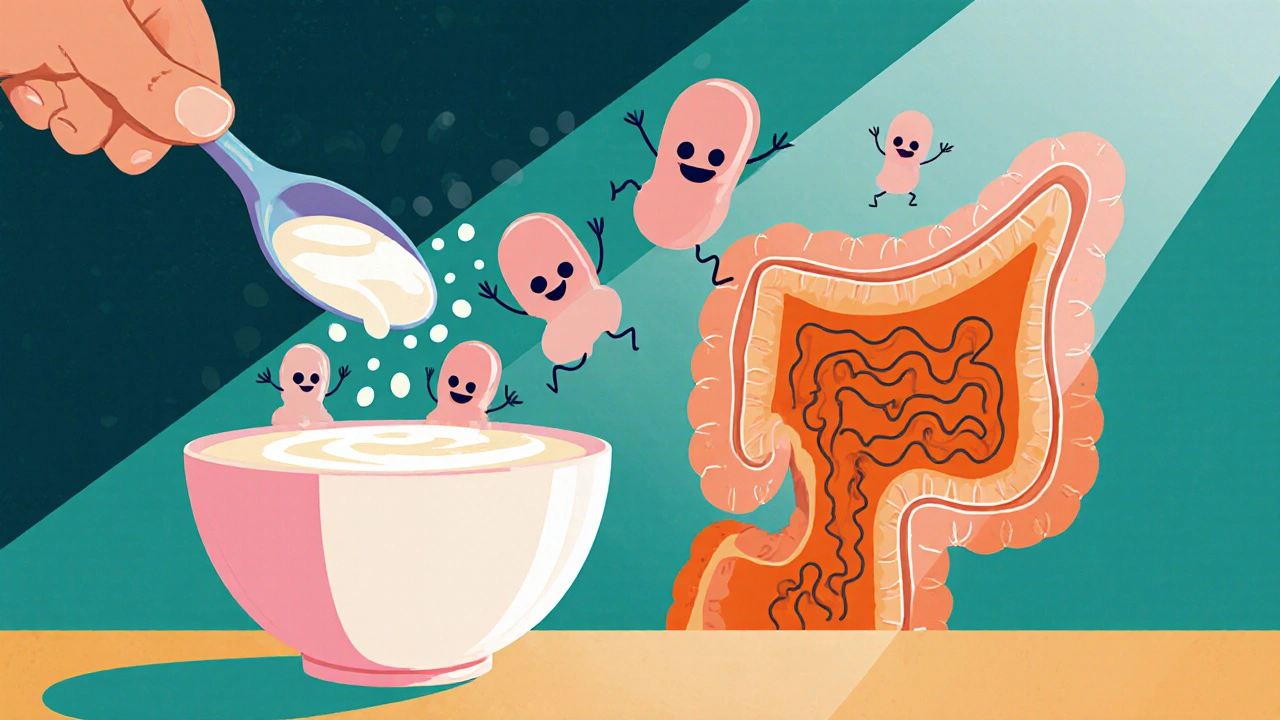Probiotic Strain Selector
Find Your Perfect Probiotic Match
Select your primary health goal and any additional factors to get personalized probiotic strain recommendations based on scientific evidence.
Ever wondered why a daily spoonful of yogurt says it’s good for your gut? The answer lies in tiny living organisms that can shift the balance of everything from digestion to mood. Understanding probiotics means uncovering how these microbes interact with your body at a molecular level.
Key Takeaways
- Probiotics are live microbes that colonize the gut and modulate health.
- Different strains (e.g., Lactobacillus, Bifidobacterium) have unique functions.
- They produce short-chain fatty acids, compete with pathogens, and train the immune system.
- Prebiotic fibers feed probiotics; together they’re called synbiotics.
- Choosing the right strain, dose, and timing maximizes benefits.
What Exactly Are Probiotics?
Probiotics are defined as "live microorganisms that, when administered in adequate amounts, confer a health benefit on the host." The concept dates back to early 20th‑century research on fermented milk, but modern science ties probiotics to the broader gut microbiome-the trillions of bacteria, archaea, fungi, and viruses living in your digestive tract.
The microbiome isn’t just a passive passenger. It digests complex carbs, synthesizes vitamins, and signals the brain via the gut‑brain axis. Probiotic strains act as a targeted boost, adding functional species that the existing community may lack.
How Probiotics Interact with the Gut Microbiome
Three core mechanisms explain their impact:
- Competitive exclusion: Probiotic cells occupy adhesion sites on the intestinal epithelium, denying space to harmful bacteria.
- Metabolic output: Many strains ferment nondigestible carbs into short-chain fatty acids (SCFAs) like acetate, propionate, and butyrate. SCFAs tighten the gut barrier, lower inflammation, and serve as fuel for colon cells.
- Immune modulation: Certain species interact with dendritic cells, prompting the production of anti‑inflammatory cytokines (e.g., IL‑10) and enhancing secretory IgA, the first line of mucosal defense.
These actions are strain‑specific. For instance, Lactobacillus rhamnosus GG excels at preventing urinary‑tract infections, while Bifidobacterium longum is a powerhouse for breaking down oligosaccharides and boosting SCFA production.

Common Probiotic Strains and Their Signature Benefits
| Strain | Primary Benefit | Typical Dose (CFU) |
|---|---|---|
| Lactobacillus rhamnosus GG | Reduces GI infections, supports skin health | 10‑20 billion |
| Lactobacillus acidophilus | Improves lactose digestion, balances vaginal flora | 5‑10 billion |
| Bifidobacterium animalis subsp. lactis | Boosts SCFA production, eases constipation | 8‑12 billion |
| Bifidobacterium longum | Enhances immune response, reduces inflammation | 5‑15 billion |
| Saccharomyces boulardii | Prevents antibiotic‑associated diarrhea | 5‑10 billion |
When choosing a supplement, match the strain to your health goal. A one‑size‑fits‑all pill rarely delivers optimal results because the gut ecosystem varies wildly between individuals.
Feeding the Friends: Prebiotics and Synbiotics
Probiotics need fuel. Prebiotics are nondigestible fibers-think inulin, fructooligosaccharides (FOS), and galactooligosaccharides (GOS)-that selectively stimulate beneficial microbes. When a product pairs a probiotic strain with its preferred prebiotic, the combo is called a synbiotic.
Research from 2023‑2024 shows that synbiotic formulations improve colonization rates by up to 30 % compared with probiotics alone. For example, a yogurt containing Lactobacillus casei plus inulin led to higher fecal counts of the strain and a measurable rise in butyrate levels.
Probiotics and the Immune System
The gut houses about 70 % of the body’s immune cells. Probiotic‑derived SCFAs signal regulatory T‑cells (Tregs) to keep inflammation in check. Studies on children with atopic dermatitis found that daily intake of Lactobacillus reuteri reduced flare‑ups by 40 % over eight weeks.
Moreover, probiotics can increase secretory IgA, which blankets the gut lining and neutralizes pathogens before they breach the epithelium. This is why athletes often consume probiotics during heavy training periods-to curb the immune dip that intense exercise can cause.

When Things Go Wrong: Dysbiosis, Antibiotics, and Probiotic Failure
Dysbiosis describes an imbalance in the microbial community, often triggered by poor diet, stress, or broad‑spectrum antibiotics. A sudden drop in beneficial bacteria can allow opportunistic species like Clostridioides difficile to proliferate.
In such cases, simply taking a low‑dose probiotic may not be enough. Strategies include:
- High‑dose, multi‑strain formulations for 2-4 weeks post‑antibiotic.
- Adding prebiotic fibers to promote regrowth.
- Considering fecal microbiota transplantation (FMT) for severe recurrent infections.
Understanding the underlying cause of dysbiosis helps you select the right remedy rather than blindly popping a capsule.
Practical Guide: Choosing the Right Probiotic for You
- Identify your goal. Want better digestion? Look for strains like Bifidobacterium animalis. Seeking immune support? Lactobacillus reuteri has solid data.
- Check the label. It should list the genus, species, and strain (e.g., Lactobacillus rhamnosus GG) plus the colony‑forming units (CFU) at expiration, not at manufacture.
- Consider delivery format. Capsules protect against stomach acid; powders mix into foods; fermented foods (yogurt, kefir, kimchi) provide live cultures plus prebiotics.
- Timing matters. Take probiotics 30 minutes before a meal or 2 hours after, depending on the strain’s acid tolerance.
- Monitor results. Keep a simple log of symptoms-bloating, stool frequency, skin changes-for 4‑6 weeks. Adjust strain or dose based on trends.
Remember, probiotics are a supplement, not a cure‑all. Pair them with a fiber‑rich diet, regular movement, and adequate sleep for the best synergy.
Frequently Asked Questions
Can probiotics survive the stomach’s acidity?
Some strains are naturally acid‑tolerant (e.g., Lactobacillus plantarum), while others benefit from enteric‑coated capsules that dissolve further down the intestine.
Do I need to take probiotics every day?
Consistency helps maintain colonization. If you’re using them for a specific condition, follow the recommended duration (usually 4‑12 weeks) and then reassess.
Are there risks associated with probiotic use?
In healthy adults, side effects are rare. Immunocompromised individuals should consult a clinician because rare cases of bloodstream infection have been reported with certain strains.
How do I know if a probiotic is high quality?
Look for third‑party testing, clear strain identification, CFU count at expiration, and storage instructions (some need refrigeration).
Can food alone provide enough probiotic benefit?
Fermented foods like kefir, kimchi, and sauerkraut contain live cultures, but the strain diversity and CFU levels can vary widely. Supplements offer a more predictable dose.
By grasping the science behind these microscopic allies, you can choose the right strains, pair them with proper prebiotic foods, and give your gut a real advantage. The next time you reach for that yogurt or capsule, you’ll know exactly why it works.


Written by Connor Back
View all posts by: Connor Back